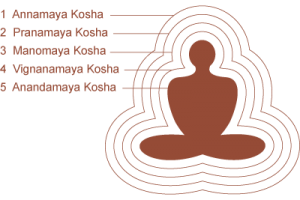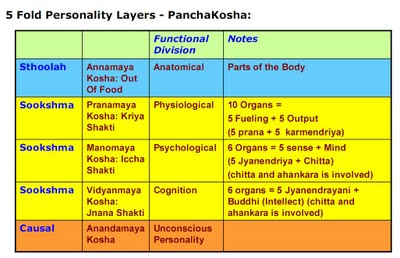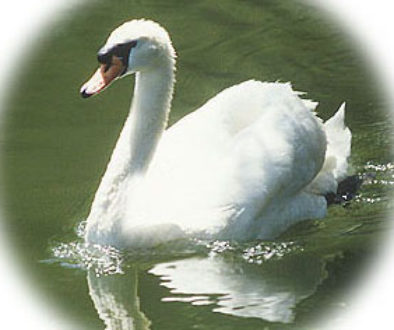Principles of Yoga Therapy
 Pancha-kosha Existence: Yoga therapy is a popular modality of Holistic medicine. This is achieved through an ancient spiritual model of the human being called the five koshas. Man is conceived as a ‘multi-bodied being’. He has at least five bodies, which are referred to as the pancha (five) kosha (body).This model describes the person as multidimensional, with the source and foundation of the person being the spiritual dimension. The limiting concept of man as Eka Kosha (only physical body) has lead to all of the limitations of Western science, whether that science be medical or philosophical. By using the five koshas as a starting point, Yoga Therapy addresses every level of the person individually and as an integrated whole.
Pancha-kosha Existence: Yoga therapy is a popular modality of Holistic medicine. This is achieved through an ancient spiritual model of the human being called the five koshas. Man is conceived as a ‘multi-bodied being’. He has at least five bodies, which are referred to as the pancha (five) kosha (body).This model describes the person as multidimensional, with the source and foundation of the person being the spiritual dimension. The limiting concept of man as Eka Kosha (only physical body) has lead to all of the limitations of Western science, whether that science be medical or philosophical. By using the five koshas as a starting point, Yoga Therapy addresses every level of the person individually and as an integrated whole.

- Annamayakosha (Physical Body): The first level to take into consideration is the physical body as understood by western science including the anatomical structures and physiological processes.
- Pranamayakosha ( Energy Body ): Enveloping this grossest dimension of man is a more subtle body, the Pranamayakosha, the ‘energy sheath’, composed of the vital energy known as prana, that which gives life to the otherwise ‘life-less’ material form. This sheath is also sometimes referred to as the ‘emotional body’ or the ‘vital body’. It is within this dimension of man that currents of prana run along specific channels (prana nadis), supplying various organs and other parts of the body with the life-giving force. From the eastern perspective, the body is an interconnected network of energy and intelligence. The proper flow of energy is necessary for maintaining good health. The energy body encompasses the pranavayus or patterns of energy within the body, the energy channels or nadhis and the energy centers or chakras. The breath forms a bridge to the energy body and the breathing patterns are a window into it. Correcting breathing patterns can enhance energy flow.
- Manomayakosha (Psycho-emotional Body): Encasing the annamaya and pranamaya koshas is yet another more subtle layer, that which is made up of conscious mind (manas) and memory (chitta), the ‘mental sheath’ or Manomayakosha. The third level to be addressed is the psycho-emotional body including the dominant emotional and thought patterns that make up the personality. These patterns are assessed in relation to the three gunas: rajas, tamas and sattva. The gunas are states of mind. Rajas refers to an aggressive, fiery or volatile state of mind. Tamas is a dull or lethargic state of mind. Sattva is the balanced state.
- Vijnyanamayakosha (Wisdom Body): Vijnanamayakosha, ‘the sheath of intellect’ encloses these lower bodies with buddhi (higher intellect). The fourth level is mind as witness. At the third level, the mind functions as stimulus/response. The actor is caught inside his/her own drama and cannot see beyond it. At the fourth level, we’re able to step out of our personal conditioning and, to some extent, look beyond our personal roles to see the larger picture of who we are. This is the level of recognizing, and de-conditioning our core beliefs. The most deeply rooted belief is, “I am my personality”.
- Anandamayakosha (Bliss Body): The fifth level is most easily explained as the level of meditation in which the mind rests in a natural state of bliss and ease. This is an important concept in terms of health and healing because it describes health as our essential nature once the confusions and distractions have been removed. Samadhi – the final level is beyond the koshas. It is a concept of complete oneness or wholeness. It is the state of mind of enlightened masters. It describes reality as a unified field, a whole in which the individual self, like a drop in the sea, has reunited with the ocean of life. These five koshas along with samadhi provide a framework for Yoga Therapy as a healing art in the truest sense.
Awareness of your body, mind and emotions:  Rather than prescribe treatments, yoga therapy encourages awareness. Without awareness there cannot be health or healing. Awareness of body implies conscious body work that needs to be synchronized with breath to qualify as a psychosomatic technique of health and healing. Through age-old yogic techniques, we get to know ourselves better. From that knowledge, comes the ability to more easily accept and adapt to change, resulting in enhanced well-being in body, mind, heart and spirit. Hence its applicability to almost all chronic conditions.
Rather than prescribe treatments, yoga therapy encourages awareness. Without awareness there cannot be health or healing. Awareness of body implies conscious body work that needs to be synchronized with breath to qualify as a psychosomatic technique of health and healing. Through age-old yogic techniques, we get to know ourselves better. From that knowledge, comes the ability to more easily accept and adapt to change, resulting in enhanced well-being in body, mind, heart and spirit. Hence its applicability to almost all chronic conditions.
Balanced food makes balanced mind: Most disorders are directly or indirectly linked to improper dietary patterns that need to be addressed in order to find a permanent solution to health challenges. One of the most important lifestyle changes that needs be implemented in management of any lifestyle disorder is diet.
Facilitate natural emanation of wastes: Facilitate natural emanation of waste from the body by practicing shuddi kriyas like dhauti, basti and neti. Accumulation and stagnation of waste materials either in inner or outer environment always causes problems. Yogic cleaning practices help wash out impurities (mala shodhana) thus helping the process of regeneration and facilitating healing.
Deep relaxation: Relaxation is most often all that most patients need in order to improve their physical condition. Stress is the major culprit and may be the causative, aggravating, or precipitating factor in so many psychosomatic disorders. The relaxation component in every Yoga session is most important. The deep rest with self awareness seeps into each and every cell producing rest, rejuvenation, reinvigoration and reintegration.
Slow and balanced breathing: Rapid, uncontrolled, irregular breathing is a sign of ill health whereas slow, deep and regular controlled breathing is a sign of health. Breath is the link between body and mind and is the agent of physical, physiological and mental unification. When breath is slowed down, metabolic processes are also slowed and anabolic activities begin the process of healing and rebuilding. If breath is calm, mind is calm and life is long!
Unblocked balanced flow of Paraná: The flow of Pranic Life Energy to all parts of the body, especially to those diseased parts is essential for healing. Prana is life and without it there cannot be healing. The different types of pranic energies driving different physiological functions of the body need to be understood and applied as per needs of the patient.
Calm and inward mind: The mind is as disturbed as a drunken monkey bitten by a scorpion say our scriptures. To bring that wayward agitated mind under control, and take it on a journey into our inner being is fundamental in finding a way out of the ‘disease maze’ in which we are entangled like a fly in the spider’s web. Breath work and sensory control are the base on which mind training can occur; hence much importance is given to pranayama and pratyahara.
Health is your responsibility: Yoga holds that a person’s health condition depends on himself. It lays emphasis on physical, mental and emotional balance and development of a sense of harmony with all of life. There’s nothing mystical about it. Nor is it external. Rather it is an inner faculty. Yoga endeavors to re-establish inner balance through a variety of ways, ranging from the gross to the subtle. This is why it is considered a holistic art. Choosing the right attitude can change everything and bring about a resolution of the problem by healing the core. Stress is more about how you react to the stressor than about the stressor itself!

Self reliance and self confidence: Life is full of challenges that are there only to make us stronger and better. The challenges should be understood as opportunities for change and faced with confidence. One must understand we have the inner power to overcome each and every challenge that is thrown at us by life.
Treatment of root cause: Contrary to modern medical science that tries to identify the pathogenic factor (be it a toxic substance, a micro-organism, or metabolic disorder) then eliminate it, Yoga takes a totally different point of view. It holds that if a person is sick there must be a deeper reason behind it – that illness doesn’t arise by chance. It is the result of an imbalance, a disruption in the body-mind complex that creates the condition. Here the symptoms, the pathogenic factors, are not the issue. Yoga believes that the root cause lies somewhere else.



